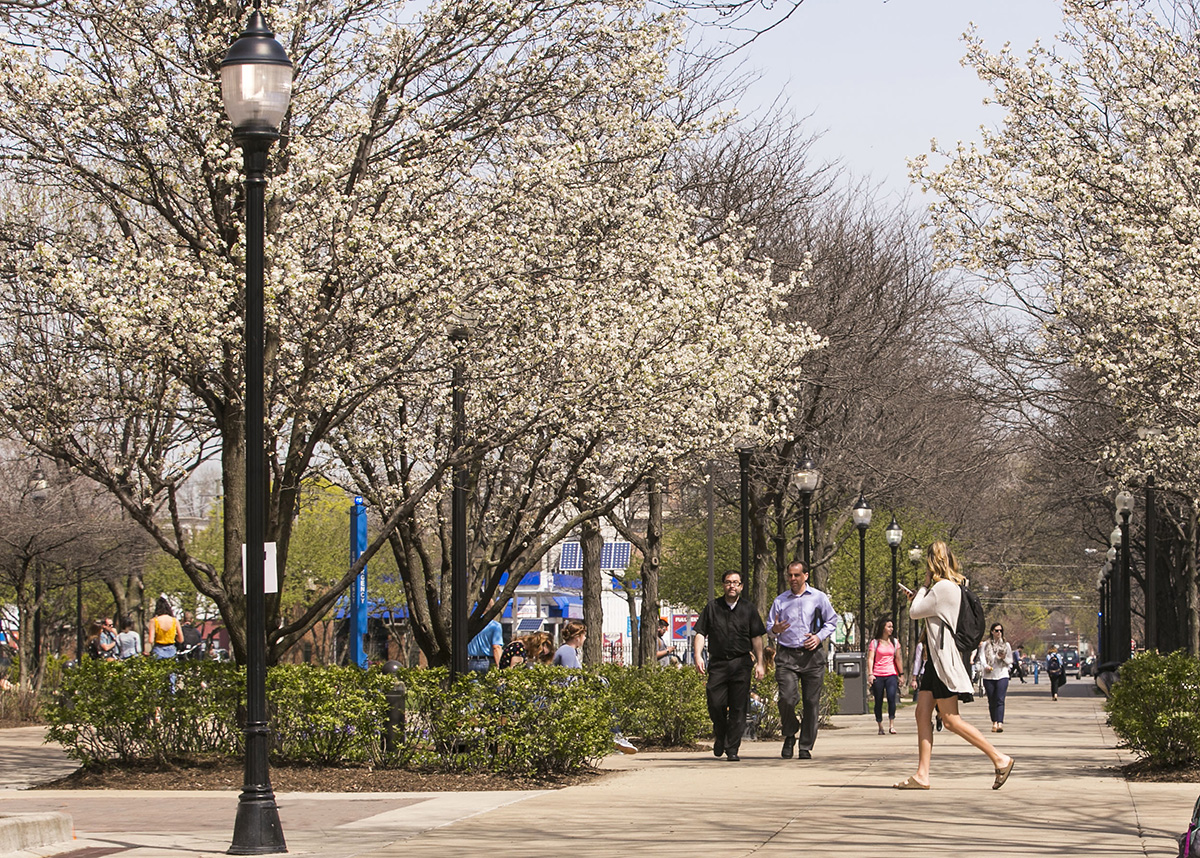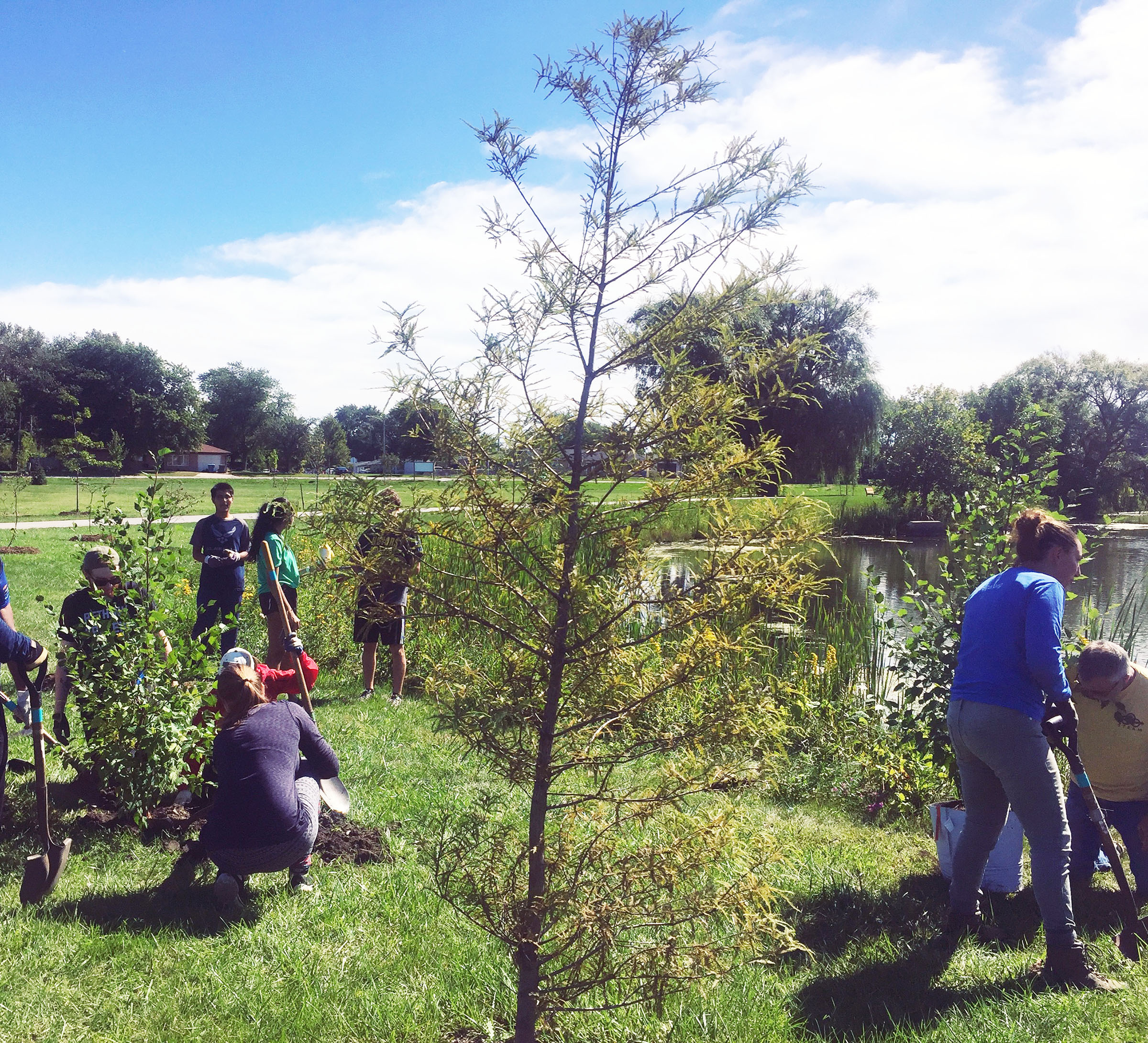 Flowering trees on the Lincoln Park Campus are among the more than 550 trees inventoried by students in a class on urban forests as social-ecological systems. The data collected by the students was among criteria submitted to earn a Tree Campus USA recognition from the Arbor Day Foundation. (DePaul University/Jamie Moncrief)
Flowering trees on the Lincoln Park Campus are among the more than 550 trees inventoried by students in a class on urban forests as social-ecological systems. The data collected by the students was among criteria submitted to earn a Tree Campus USA recognition from the Arbor Day Foundation. (DePaul University/Jamie Moncrief)Just in time for spring, DePaul has been recognized as a Tree Campus USA by the Arbor Day Foundation. This is the first time DePaul has received the distinction, which honors universities for promoting healthy trees and engaging students and staff in the spirit of conservation.
“Tree Campuses and their students set examples for not only their student bodies but the surrounding communities showcasing how trees create a healthier environment,” says Dan Lambe, president of the Arbor Day Foundation.
The idea to have DePaul recognized as a Tree Campus USA grew from a 2017 class — ENV 341: Urban Forests as Social-Ecological Systems — taught by sustainability scientist, Jess Vogt, an assistant professor in the Environmental Science and Studies Department in the College of Science and Health.
Kaitlyn Pike, a graduate student and SGA senator for sustainability, explains the class conducted a thorough inventory of trees on the Lincoln Park Campus (354 campus trees and 199 street trees) and at the time learned about the Tree Campus USA program.
“In ENV 341, we learned how to do an inventory, how to measure the trees, and do a qualitative and a quantitative survey of the diversity of species on campus. We learned how trees and people interact,” says Pike, who after earning a bachelor’s degree in environmental studies with a concentration in sustainability last year, is now working toward a master’s degree in environmental science.
Mapping the data
The Lincoln Park Campus inventory data — location and species of trees — was digitized by senior Rasa Whittaker, who is majoring in environmental studies and geography. The
interactive map she created pinpoints where honeylocust, sugar maple, crabapple, hawthorn, slippery elm and other trees are planted on campus.
Whittaker and Pike are student scientists in Vogt’s research group, LUFA, the
Lab for Urban Forestry in the Anthropocene. Urban forestry, according to the LUFA website, is the study and practice of installing, maintaining, preserving, and stewarding all of the trees, forests, greenspace, gardens, parks, and other vegetation in and around the cities, towns, and communities where people live, work, play, and go to school.
“I teach the urban forestry class every other year and each week during the class we go somewhere in the Chicago region to learn from an expert in the field,” Vogt says. “We’re really lucky Chicago has a pretty robust urban forest with lots of people and groups working to make the city greener.”
“With the Tree Campus USA application, we wanted to bring more attention to the trees on campus,” notes Pike, who with fellow classmates formed a tree club, the DePaul Student Tree Committee, which advocates for trees on and off campus. They post on Instagram at
www.instagram.com/depaultrees.
 Members of the DePaul Student Tree Committee joined alumni from the Student Conservation Association and others to plant more than 75 trees Sept. 23, 2018, in Hammond, Indiana. The tree planting weekend, one of 16 in 2018, fulfilled a service learning project standard to earn a Tree Campus USA recognition from the Arbor Day Foundation. (Photo courtesy of Kaitlyn Pike)
Members of the DePaul Student Tree Committee joined alumni from the Student Conservation Association and others to plant more than 75 trees Sept. 23, 2018, in Hammond, Indiana. The tree planting weekend, one of 16 in 2018, fulfilled a service learning project standard to earn a Tree Campus USA recognition from the Arbor Day Foundation. (Photo courtesy of Kaitlyn Pike)As part of a collaboration between the Student Tree Committee and research Vogt is conducting, students volunteered with the
CommuniTree initiative and helped plant hundreds of trees in underserved communities throughout northwest Indiana over 16 weekends in the spring and fall of 2018.
Restorative nature
One of the ecological benefits of urban trees, according to Vogt is that they make the city a more pleasant place to live.
“Research shows that being in nature is restorative: as students walk across campus, the trees provide an invigorating feeling and help restore the ability to focus,” Vogt says. “And, trees are a link to the natural world beyond the city. They are a way people can interact with nature, by planting, watering and taking care of trees.”
Vogt credits Pike with pulling together the data to meet the core standards for effective campus forest management that was required by the Arbor Day Foundation. And Pike gives a hat tip to Eric Fredericks, grounds foreman, and Bob Janis, vice president of Facility Operations.
“They were especially helpful in helping us put together a campus tree care plan,” which discusses tree planting, pruning and removal practices, says Pike. The campus tree care policy must adhere to a Chicago municipal code, which specifies the practice of “right tree, right place.”
“We’ve been careful in approaching how we work with trees over the years,” explains Janis, noting the care that went into selecting and planting trees on the quadrangle almost 30 years ago. “We selected specimens hearty enough to survive transplant shock as well as Chicago weather. We also collaborate with our design consultants in selecting trees that will complement the design of the buildings.”
Event planning is underway for DePaul students to celebrate Earth Day (April 22) and Arbor Day (April 26), according to Pike. Among activities will be bird watching and tree identification workshops, a beach cleanup, bike checkup at The Ray, tree planting with the Student Conservation Association, an Urban Farming Organization art show, DePaul Fair Trade Committee conference and the EDGE Team’s Earth Week Festival.